How to Stream Tournaments: Essential Guide to Esports Streaming Success
Updated On: November 13, 2025 by Aaron Connolly
Choosing the Right Streaming Platform
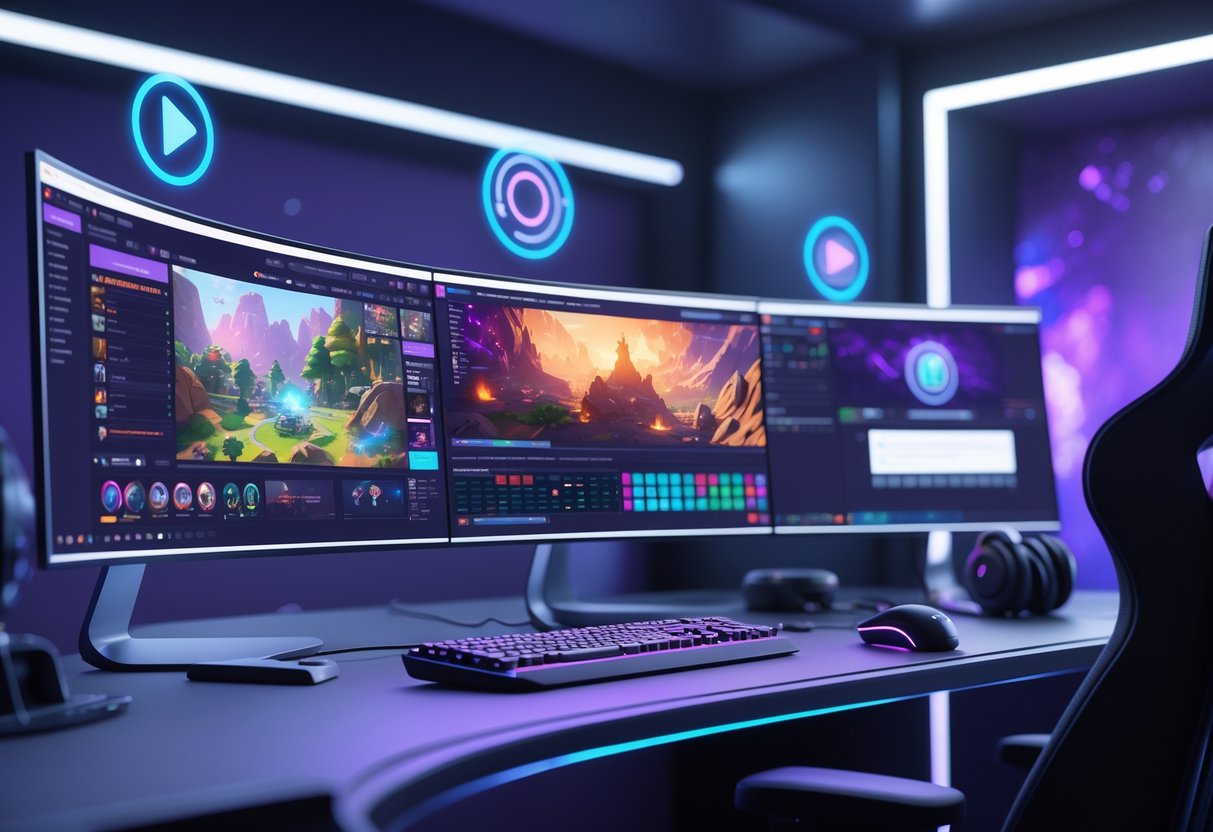
The streaming platform you pick really shapes your whole tournament broadcast. Each big platform draws different crowds, offers its own monetisation features, and has quirks that can totally change your streaming success.
Twitch vs YouTube Gaming vs Facebook Gaming
Twitch still sits at the top for live gaming content. It pulls in hardcore gamers and esports fans who want solid tournament coverage.
Viewers on Twitch love to chat during matches. The monetisation tools—bits and subs—work great for those streaming regularly. But honestly, getting discovered is tough since so many people are streaming at once.
YouTube Gaming gives you massive reach thanks to Google’s search. Tournament streams show up alongside regular YouTube videos and get recommended a lot.
YouTube really shines after the event. Highlights and replays often get more views than the live stream did. Monetising through ads brings in steady income, and you don’t have to rely on donations as much.
Facebook Gaming goes after casual crowds by plugging into social media. Friends and family can stumble onto your stream and share it around.
It’s perfect for local tournaments or community events. Still, the hardcore esports fans usually stick with Twitch because it feels more dedicated to gaming.
Platform Features Comparison
| Feature | Twitch | YouTube Gaming | Facebook Gaming |
|---|---|---|---|
| Live chat moderation | Excellent | Good | Basic |
| Stream quality options | Up to 1080p/60fps | Up to 4K/60fps | Up to 1080p/30fps |
| Monetisation | Subs, bits, ads | Ads, memberships | Stars, ads |
| Discovery | Gaming-focused | Search-driven | Social sharing |
| VOD storage | 14-60 days | Unlimited | 30 days |
Chat features really matter for tournaments. Twitch has the best moderation tools and that emote culture everyone expects during big matches.
Stream reliability isn’t the same everywhere. YouTube almost always delivers solid uptime, while Facebook Gaming sometimes lags during busy times.
Mobile streaming is possible everywhere, but Twitch’s app just feels smoother if you’re running things on the go.
Selecting a Platform for Your Audience
Go with Twitch if you’re streaming competitive esports. The audience expects tournaments here and actually joins in with the action.
Most pro esports orgs use Twitch as their main hub. You’ll find big communities for games like Counter-Strike, League of Legends, and Valorant.
Try YouTube Gaming if you want your content to last. Tournament VODs keep showing up in search results long after the event.
YouTube is great for educational or beginner-friendly tournaments. The algorithm tends to push helpful, engaging content.
Pick Facebook Gaming for local or community tournaments. Social sharing makes it easy for friends and groups to tune in.
Facebook seems to work best for mobile gaming tournaments, especially with a more casual (and often older) crowd than Twitch.
You can also multi-stream using tools like Restream. This gets your tournament in front of more eyes, but you’ll need more bandwidth and a way to keep an eye on all the chats.
Preparing for an Esports Tournament Stream
Dialing in your streaming setup before you go live can be the difference between looking amateur and coming off as a pro. You’ll want the right gear, software that won’t freeze up, and internet speeds that can handle all your camera feeds without stuttering.
Essential Equipment and Hardware
Start with basic multi-camera gear that won’t empty your wallet. You should have at least two cameras to keep the stream interesting.
Your main camera needs to focus on the gameplay or the tournament stage. Even a good USB webcam (£40-80) does the trick for beginners. If you’re feeling fancy, a DSLR (£300-600) and a capture card (£100-200) look amazing.
Secondary cameras catch player reactions, commentary, and crowd shots. Sometimes, even a smartphone with a tripod is enough.
Don’t overlook audio. A USB mic like the Audio-Technica ATR2100x-USB (£160) gives you clear commentary. Avoid built-in camera mics—they pick up way too much background noise.
Lighting can make a bigger difference than an expensive camera. Two softbox lights (£60 each) will get rid of harsh shadows. Put them at 45-degree angles to keep glare off the screens.
Pro tip: Test everything together before the tournament. Loads of people only find out about compatibility issues when they’re already live.
Software and Streaming Tools
Cloud-based streaming software saves you from needing a crazy-powerful PC. OneStream Live runs in your browser and handles multi-camera switching with barely any lag.
Multi-camera control lets you jump between gameplay, reactions, and wide shots. Most platforms handle up to four camera feeds at once.
Overlay management is key for displaying live scores, player names, and sponsor graphics. Prep your overlays before the event—adding them on the fly just looks messy.
Multi-streaming to Twitch, YouTube, and Facebook at the same time gives your tournament a bigger audience.
Heads up: Free streaming software can crash when things get busy. Budget £20-50 a month for something reliable.
Integration with each platform isn’t always smooth. Twitch, YouTube, and Facebook all use different stream keys and settings.
Setting Up Internet and Network
Streaming tournaments needs stable upload speeds—at least 10 Mbps per platform. If you’re multi-streaming, you’ll want 30+ Mbps.
Ethernet always beats Wi-Fi for streaming. Wireless drops are a nightmare during big moments and cause buffering for viewers.
Bandwidth adds up fast with more cameras. Each HD camera uses 3-5 Mbps. Here’s a rough breakdown:
- Single camera: 5-8 Mbps
- Two cameras: 10-15 Mbps
- Four cameras: 20-25 Mbps
Test your connection at the same time of day as your event. Evening streams compete with everyone else’s Netflix marathons.
Backup internet can save your tournament if your main connection dies. Mobile hotspots work in a pinch, but they get pricey quick.
Keep an eye on your stream health. Most software gives you a warning before things get really bad. If you see issues, cut back on camera feeds or lower the resolution until things smooth out.
Setting Up Multi-Camera Streaming
Multi-camera setups take your stream from basic to pro. You’ll want to think about where to put the cameras, how to get clean audio, and how to switch scenes without making it awkward.
Camera Placement for Gameplay and Reactions
Player reaction cameras should go at eye level, about 2-3 feet from the players. This catches real emotion but doesn’t get in the way. Try a 45-degree angle so you don’t block screens or cast shadows.
Gameplay cameras should capture the game directly, not just film the monitor. Use capture cards to pull the game feed into your software. This gets rid of glare and keeps things sharp.
Wide-angle shots look best from up high. Set up tripods at the back of the room or on a balcony to show off the crowd and venue.
Overhead shots are great for fighting games or RTS titles. Mount a lightweight camera on an arm about 3-4 feet above the gaming stations.
Think about the game when planning your shots. MOBAs need team reaction cams, but fighting games look better with close-ups of the players’ hands.
Audio Equipment and Commentary
Commentary audio works best with mics separate from all the background noise. Headset mics or boom arms, placed 6-8 inches from the commentators, keep things clear. The Audio-Technica ATR2100x-USB (£199) is a solid pick.
Player comms need wireless lav mics clipped to shirts or built into their headsets. The Rode Wireless GO II (£299) can handle two at once, no problem.
Ambient crowd audio comes from shotgun mics placed around the venue. These pick up hype and reactions but don’t catch every random conversation.
Audio mixing keeps everything balanced. The Behringer Xenyx 1202FX (£130) gives you 12 channels and some effects. Run commentary, player audio, game sound, and crowd noise on their own channels.
Test your audio levels before you go live. Commentary should land around -12dB, game audio at -18dB, and crowd noise at -20dB to avoid distortion.
Switching Scenes and Overlays
Hardware switchers like the Blackmagic ATEM Mini (£295) let you swap between four camera feeds with a button press. You can jump from player cams to gameplay or wide shots in a second.
Software switching with OBS Studio gives you more options, but someone needs to run it. Set up scenes like “Player Focus,” “Gameplay Only,” and “Crowd Reaction” ahead of time.
Overlays show brackets, stats, and sponsors. Keep them simple during the game so you don’t distract viewers. Use bold, contrasting colours so they’re always readable.
Timing your transitions really matters. Cut to player reactions after big plays, switch back to gameplay during setups, and show the crowd between matches.
Set up hotkeys for fast scene changes. Assign F1-F4 to your main camera angles so you can react instantly as the action unfolds.
Broadcasting Popular Esports Titles
Each esport needs its own streaming approach. Every game has unique gameplay, different viewer expectations, and its own technical needs. Here’s what you should know about the three biggest competitive titles.
League of Legends
League of Legends is still the most-watched esport worldwide. The top-down view makes it easy for viewers to follow the action.
Key streaming needs:
- Resolution: At least 1080p so everyone can see champion details
- Frame rate: 60fps for smooth team fights
- Overlay: Show champion stats, gold, and kills
The League of Legends World Championship pulls in over 100 million viewers every year. That’s a huge audience for analysis, commentary, and reaction streams.
Popular formats:
- Live tournament co-streams with your own commentary
- Post-match breakdowns and highlights
- Teaching streams that explain team strategies
Riot Games lets you co-stream most events, but you have to follow their rules—no ads during official broadcasts.
The game’s long competitive history means you’ll never run out of content ideas. Many streamers focus on breaking down team strategies for newer fans.
Fortnite
Fortnite’s battle royale style brings its own challenges. With 100 players in every match, stuff happens all over the map, and the action never really stops.
Technical musts:
- Multiple views: Jump between player perspectives
- Map coverage: Always show the storm circle and player locations
- Building: Capture fast builds clearly
Younger viewers love Fortnite, so streams tend to have more energetic commentary. Fast cuts and hype moments work better than long, slow analysis.
Winning Fortnite streams focus on:
- Showing off insane building skills
- Following big-name streamers and creators
- Capturing eliminations and clutch plays
Epic Games offers official tournament feeds for co-streaming, and their creator program shares revenue with qualifying streamers.
Frequent updates and new seasons mean there’s always something new to stream. Many broadcasters keep their audience by breaking down new weapons, map changes, and gameplay tweaks.
Dota 2
Dota 2 delivers the most complicated viewing experience out of all the big esports titles. If you’re new, you’ll probably need someone to break things down just to follow what’s happening.
Broadcasting essentials:
- Hero ability explanations: Let’s be honest—almost no one knows all 120+ heroes.
- Economy tracking: Gold and item progression shape every match.
- Team fight breakdowns: Slow-motion replays make sense of those wild, chaotic clashes.
Dota 2 tournaments bring in the biggest prize pools in esports. In 2023, the prize pool shot past $29 million. If you care about competitive gaming, you can’t really ignore it.
The best Dota 2 streams usually offer:
- Simple explanations for beginners during farming lulls
- In-depth item build talk
- Post-fight replays to highlight what tipped the battle
Valve actually wants the community to broadcast through DotaTV. You can jump into any pro match via the game client and see every player’s view and stats.
Because Dota 2 is so tricky to learn, educational content gets a ton of traction. The most popular Dota 2 streamers often teach strategy instead of just showing flashy plays.
Streaming Counter-Strike: Global Offensive & Other Top Games
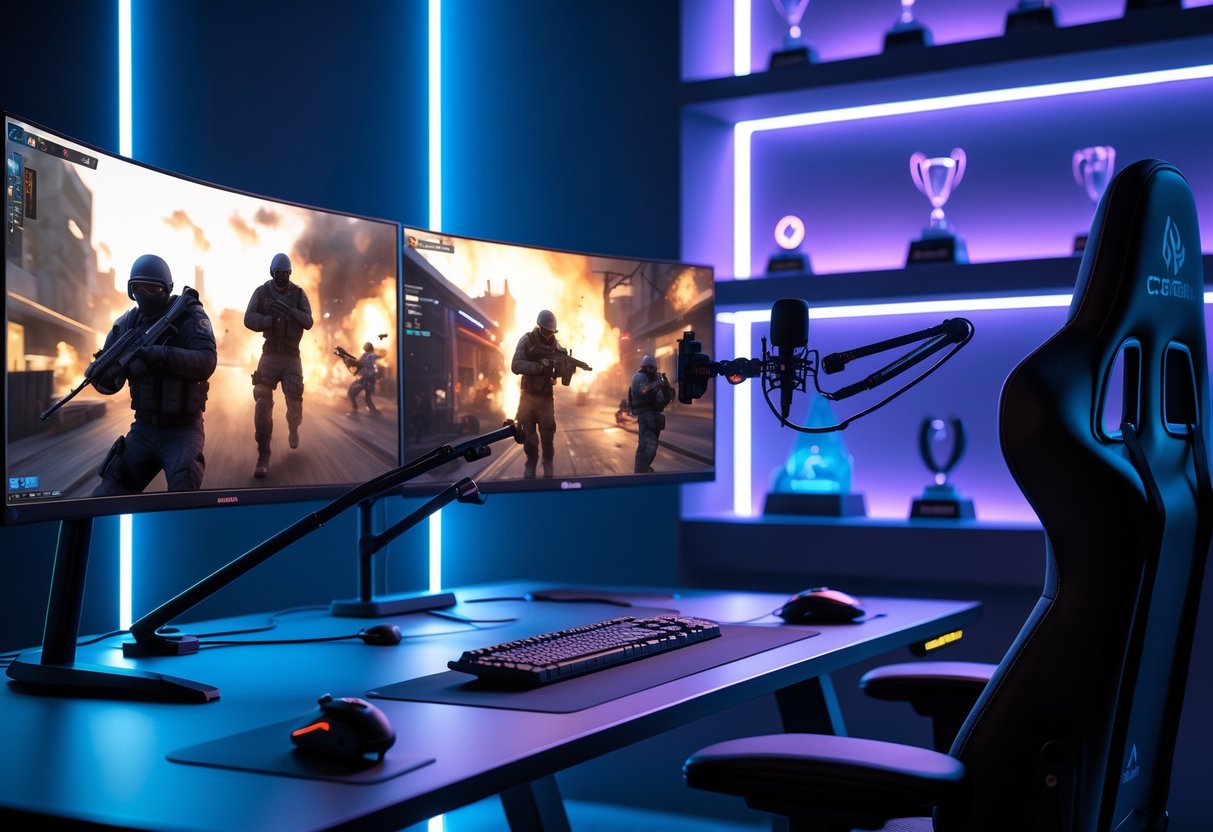
Counter-Strike: Global Offensive rules the streaming world, with millions tuning in to major tournaments on Twitch and Steam. Dota 2 and League of Legends also pull massive crowds across different platforms.
Counter-Strike: Global Offensive
Counter-Strike: Global Offensive stands among the top three most-watched esports. Both die-hard fans and newcomers show up for the big events.
Twitch is the main hub for CS streams. Most professional tournaments air live on esports channels, and the chat is always buzzing during matches.
ESL (Electronic Sports League) runs the CS Pro League. If you want regular action, this is the league to follow.
Steam’s own platform gives out exclusive in-game drops during select tournaments. You can score weapon skins and other loot just by watching.
YouTube Gaming streams live matches and posts replays. If you miss the live show, YouTube has you covered.
CS tournaments come in all shapes—Majors, Minors, regional qualifiers. Each type offers different prize money and ways for teams to qualify.
Other Trending Esports Tournaments
League of Legends streams mainly on Twitch and YouTube. Their World Championship pulls over 100 million viewers every year.
Dota 2 events run on Steam, Twitch, and YouTube at the same time. The International’s prize pool regularly breaks $40 million.
Valorant shot up in streaming popularity since it launched in 2020. Riot Games hosts official tournaments on Twitch and signs exclusive deals.
Most big esports titles now stream on several platforms. You can pick Twitch for chat, YouTube for replays, or official game clients for special rewards.
Mobile esports like PUBG Mobile and Free Fire are booming fast. They stream on regional sites as well as global ones like Facebook Gaming and YouTube.
Best Practices for Live Tournament Streaming
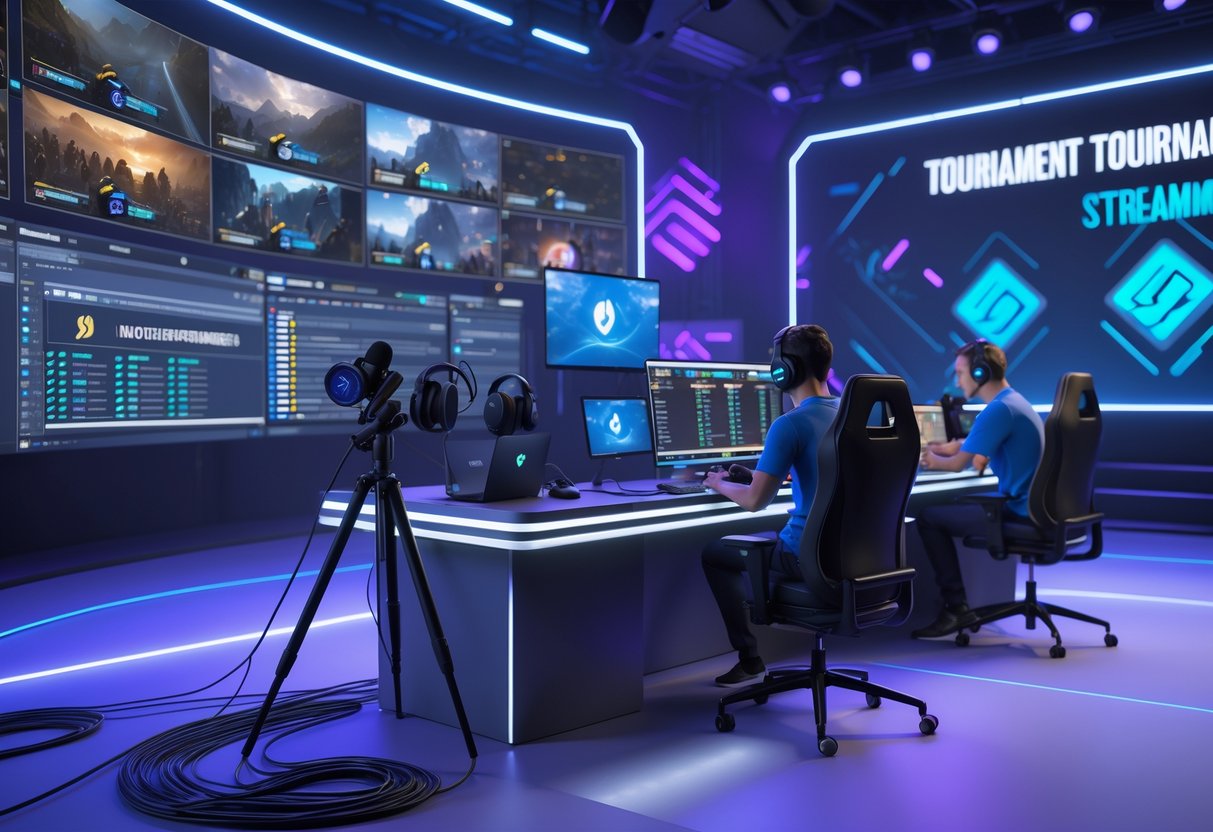
To stream well, you need a solid setup, active viewers, and smooth technical work. If you want your stream to look pro, you’ll have to handle delays, keep chat under control, and nail the broadcast quality.
Optimising Broadcast Quality
Internet Connection Standards
Your upload speed sets your stream’s ceiling. For 1080p, you’ll want at least 5 Mbps up.
Wired ethernet always beats Wi-Fi. If you’re stuck with wireless, get as close to your router as possible and use 5GHz.
Video Settings That Work
Set your bitrate to about 80% of your upload. A 10 Mbps line can handle 8000 kbps safely.
For fast games like Rocket League, go 1080p at 60fps. Slower games can run fine at 30fps.
Audio Quality Basics
Keep game audio at -12dB and let commentary peak at -6dB. This keeps things from blowing out during hype moments.
USB mics like the Audio-Technica ATR2100x-USB sound great for under £200. Laptop mics? Just don’t.
Equipment Essentials
| Component | Budget Option | Professional Choice |
|---|---|---|
| Capture Card | Elgato HD60S (£150) | Magewell Pro (£300) |
| Microphone | Blue Yeti (£100) | Shure SM7B (£350) |
| Camera | Logitech C920 (£80) | Sony A6000 (£400) |
Effective Audience Engagement
Pre-Stream Promotion
Announce your tournament stream a day or two in advance on all your socials. Mention match times and who’s playing.
Make countdown graphics with start times for different time zones. Esports fans come from everywhere.
Interactive Elements During Streaming
Run chat polls between matches so viewers can predict winners. It keeps things lively when there’s downtime.
Answer questions in chat about strategy or player backgrounds. People love those little insights.
Commentary Techniques
Explain the basics for new viewers, but don’t forget to dive into tactics for the veterans. Striking that balance is key.
Quick win: Use picture-in-picture to show player faces during clutch moments. Their reactions tell a story the gameplay can’t.
Bring in guest analysts or ex-pros as co-casters. Their takes give your stream real credibility.
Building Community
Set up a Discord for match chat before and after streams. It helps keep the hype going even when you’re offline.
Host small giveaways like game keys or merch. Even £20 prizes can get people involved.
Managing Stream Delays and Moderation
Understanding Stream Latency
Standard RTMP streaming usually brings a 15-30 second delay. It slows down chat but keeps the stream stable.
Low-latency modes cut that to 2-5 seconds, but you’ll need more bandwidth and might see buffering.
Chat Moderation Setup
Pick your moderators before the event. One mod for every 100-200 viewers is a good rule.
Set up automod filters for toxic language. Slow mode helps when chat gets wild.
Technical Backup Plans
Always have a backup internet option ready. If your main connection dies, a mobile hotspot can save you.
Warning: Test all your gear at least half an hour before going live. A tech fail during finals? That’s a nightmare for everyone.
Use OBS or similar software with scene collections for quick changes. Pre-set scenes for breaks and results make everything smoother.
Keep emergency contact info for platform support handy. Fast fixes stop you from losing viewers if something breaks.
Watch your stream health dashboard. If you spot dropped frames or encoder errors, you can jump on them before viewers start complaining.
Monetisation and Sponsorship Opportunities
Streaming tournaments opens up a bunch of ways to earn money: sponsorships, donations, and smart ad deals. If you build relationships with brands and keep your viewers engaged, you’ll grow both your income and your tournament’s reach.
Attracting Sponsors and Partners
Start with gaming brands that fit your audience. Hardware makers, energy drinks, and peripherals companies are always looking for esports partners.
Put together a sponsorship package that shows what you offer. Include your viewer numbers, audience stats, and engagement from past streams.
Sponsor perks you can offer:
- Their logo on your stream overlays
- Product shout-outs during matches
- Social media posts and promotions
- Banner ads on your tournament site
Reach out to local businesses first. UK gaming cafes, tech stores, and student brands often want exposure but don’t have huge budgets.
Aim for long-term partnerships instead of one-offs. Sponsors like working with organisers who deliver and look professional.
Peripheral brands sometimes send gear as prizes instead of cash. This saves money and gives sponsors a spotlight.
Keep things professional. Make media kits with screenshots, stats, and sponsor testimonials.
Donation and Subscription Models
Set up several donation options so everyone finds something that works. Twitch subs, StreamLabs, and PayPal all appeal to different folks.
Use donation goals that help the tournament—like boosting the prize pool, upgrading your stream, or booking a special guest.
Subscription tiers for regular events:
- Basic: Ad-free viewing
- Premium: Extra behind-the-scenes stuff
- VIP: Direct chat access to organisers
Offer perks like exclusive brackets, early previews, or voting on new formats for subscribers.
Turn on bits and channel points on Twitch for bonus income. Fans love using these during big moments.
Thank donors and subs on-stream right away. That little recognition pushes more people to chip in.
Set donation targets that make sense. £50-100 goals work way better than shooting for £1,000+ and scaring folks off.
Advertising and Promotion
Pre-roll and mid-roll ads bring in steady cash on Twitch and YouTube. Tournament viewers are usually pretty engaged and watch the ads.
Team up with gaming content creators for cross-promo. They’ll shout out your tournament; you can feature their clips during breaks.
Affiliate deals can include:
- Gaming chairs and desks
- Streaming software subs
- Tournament platforms
- Energy drinks or snacks
Sell branded merch like shirts, stickers, or digital wallpapers. It’s another income stream and helps your brand stick.
Use social ads smartly. Facebook and Twitter ads aimed at gamers cost less than broad campaigns.
Offer premium viewing for a small fee—like extra camera angles, pro commentary, or deep match analysis.
Try sponsored segments between games. Quick product reviews, gaming tips, or news keep viewers watching and pay the bills.
Promoting Your Tournament Stream
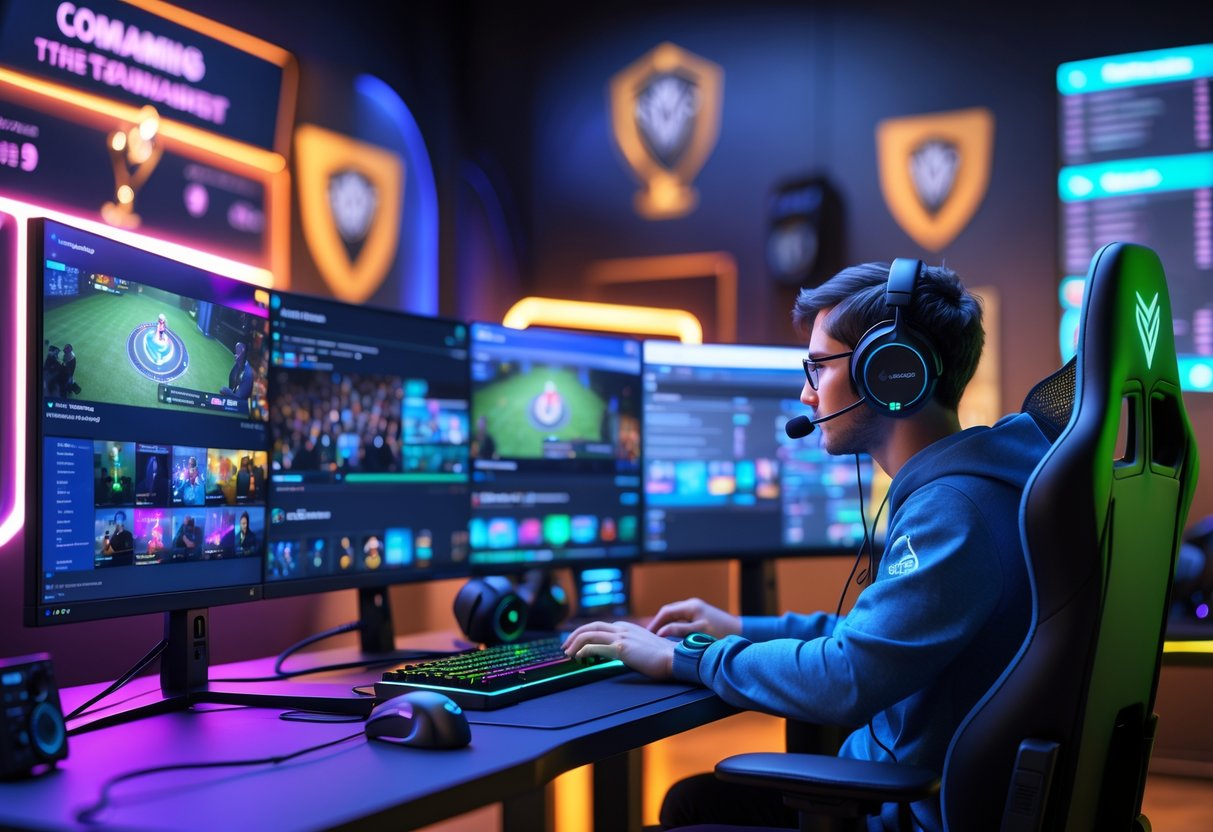
Getting eyes on your tournament means promoting it everywhere you can. The trick is building hype on social, teaming up with gaming influencers, and growing a loyal community around your events.
Utilising Social Media
Twitter is still the go-to for esports. Share highlights, player interviews, and behind-the-scenes moments every day. Hashtags like #esports, #tournament, and game-specific tags help you reach the right crowd.
TikTok is perfect for short tournament clips. Post 15-30 second highlights of the wildest plays. Sometimes these go viral and send new viewers your way.
Discord servers hype up your event before it starts. Share updates, brackets, and chat with your fans. Some tournaments see up to 60% of their viewers coming from Discord.
Keep posting on every platform. Share schedules a week or two before the event. During matches, drop live updates and big moments. Afterward, post results and thank everyone who joined.
Instagram Stories work great for quick updates and polls. Use the countdown sticker to remind people when the tournament kicks off.
Collaborating with Influencers
Try partnering with gaming streamers who play the same games as your tournament. Plenty of streamers will promote events if you offer them hosting rights or a little cash.
Start by contacting micro-influencers. Streamers with 1,000-10,000 followers often get better engagement than the big names. They’re also way more budget-friendly for smaller tournaments.
YouTube creators can build hype by making preview videos about your tournament. Give them early access to player interviews or some exclusive content. Their subscribers love this kind of anticipation.
Gaming journalists and esports analysts can help get the word out for bigger events. Send over press releases and offer up interviews with your top players.
Pro players in your tournament should talk about it on their own channels. Ask them to mention the event during their regular streams. Most players are happy to promote tournaments they’re playing in.
Let everyone know exactly what kind of promotion you need. Hand over graphics, hashtags, and the key info to make sharing quick and painless.
Building a Community
Start working on your community months ahead of your first tournament. Set up dedicated social media accounts and a Discord server for your tournament series.
Share content regularly between events. Post player spotlights, game tips, and news from the industry. This keeps people interested, even when tournaments aren’t running.
Email lists are great for tournament announcements. Collect emails when people register and send updates about what’s coming up. A lot of organisers see 20-30% of their viewers come from email blasts.
Host smaller weekly or monthly events to keep your community buzzing. These don’t need big prizes—just fun, regular competitions to keep folks engaged.
Chat with your community directly. Respond to comments, answer questions, and ask for feedback. If people feel heard, they’re way more likely to tell their friends about your events.
Loyalty programmes go a long way for regular viewers. Offer early access, merch discounts, or special chat roles. This gives people a reason to keep coming back and become true fans.
Legal Considerations and Broadcasting Rights
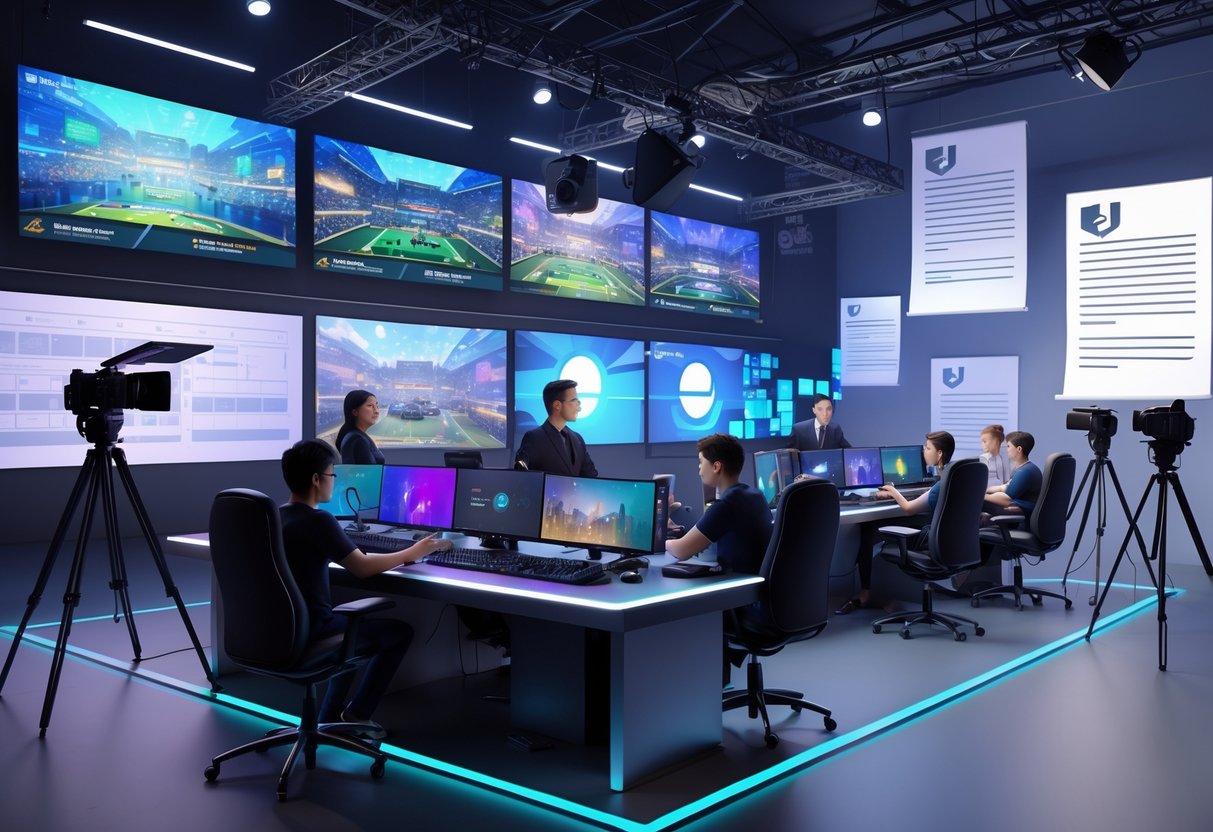
Streaming tournaments means you have to deal with tricky legal requirements around game permissions, copyrights, and broadcasting rules. Organisers need to get the right licences from game publishers, sort out music rights, and follow broadcasting laws so you don’t run into expensive legal trouble.
Securing Game Publisher Permissions
Game publishers own the copyright for their games and control broadcasting rights. Always get written permission before streaming any tournament with their titles.
Most big publishers—like Riot Games—have clear policies for esports tournaments. Riot lets you stream League of Legends events, but you need advance approval for commercial broadcasts.
Reach out to the publisher’s esports division at least 30 days before your event. Give them details like:
- Tournament format and prize pool
- Expected viewership numbers
- The platforms you’ll broadcast on
- How you plan to make money
Heads up: Many publishers want separate permissions for live streams and archived content. Don’t just assume one covers both.
Some games use third-party assets that need extra clearance. Even after you get publisher approval, this can add more hoops to jump through.
Copyright and Music Licences
In-game music and sound effects usually need separate licences from groups like PRS for Music in the UK. Publishers rarely own those musical rights.
When you add commentary or analysis, you create extra copyright considerations. You own your original commentary, but if you use copyrighted music in overlays or breaks, you need a licence.
Twitch and other platforms will mute copyrighted audio automatically. That can ruin your broadcast if you haven’t sorted out the music licences.
Set aside around £200-500 for basic music licensing, depending on your tournament size. Contact PRS for Music directly to get the right rates for your event.
Quick tip: Use royalty-free music libraries like YouTube Audio Library to skip licensing fees altogether.
Keep records of all permissions and licences. If anyone questions your rights later, you’ll have the paperwork to back it up.
Broadcasting Regulations
UK broadcasting rules can apply to your tournament streams, depending on audience size and how you make money. Ofcom oversees commercial broadcasts.
If you’re live streaming with sponsorships or prize money, you’ll probably need to follow commercial broadcasting rules. That means sticking to advertising standards and content guidelines.
Always label sponsored content and paid promotions clearly during your broadcasts. If you don’t, you’re breaking ASA (Advertising Standards Authority) rules.
Data protection laws like GDPR kick in when you collect viewer info or use analytics. Make sure you include privacy notices explaining how you handle data.
International tournaments get even trickier, since you might need to follow broadcasting laws in each country where you have viewers.
If your prize pool is over £10,000 or you have international players, think about getting professional legal advice.
Analysing Tournament Performance and Viewer Insights

If you want to understand how your tournament performed, you need to track the right numbers during and after your stream. The trick is figuring out which stats matter most for growing your audience and making your next event even better.
Real-Time Stats and Analytics Tools
Most streaming platforms show live viewer data as your tournament happens. Twitch, for example, gives you real-time concurrent viewership, chat activity, and follower growth through its Creator Dashboard.
Key metrics to watch:
- Peak concurrent viewers (your highest reach)
- Average view duration (how long people stick around)
- Chat engagement rate (how active your chat is)
- Viewer retention throughout matches
Third-party tools like Streamlabs and StreamElements dig even deeper. They show viewer demographics, traffic sources, and audience overlap across streams.
Esports Charts and Streams Charts track watch time on multiple platforms and show audience behaviour during different match types.
While live, keep an eye on chat spikes. High engagement usually means something exciting just happened, which helps you figure out which formats people like best.
A lot of organisers notice that viewer retention drops during long breaks. If you monitor in real time, you can tweak your schedule on the fly.
Applying Insights for Future Streams
After the tournament, look for patterns that can help you next time. Compare your peak viewership times to the tournament schedule to find the best match slots.
Viewer duration data tells you which formats keep audiences watching. Best-of-three matches often hold attention better than single elimination, though it depends on the game.
Geographic data is super helpful for scheduling. If most of your viewers are in Europe, don’t stream during their work hours. Analytics show exactly where your audience is tuning in from.
Chat engagement rates highlight your best co-streamers or commentators. Channels with more chat activity usually do better for sponsors and keep audiences coming back.
Audience overlap analysis helps you see what the competition is doing. If another tournament targets the same viewers, maybe try a different schedule or unique content.
Quick tip: Make a simple spreadsheet tracking peak viewers, average duration, and chat activity for each event. This baseline helps you see what’s working.
Don’t get caught up in vanity metrics like total views. Focus on real engagement and watch time instead.
Watching Esports Tournaments Online and on TV
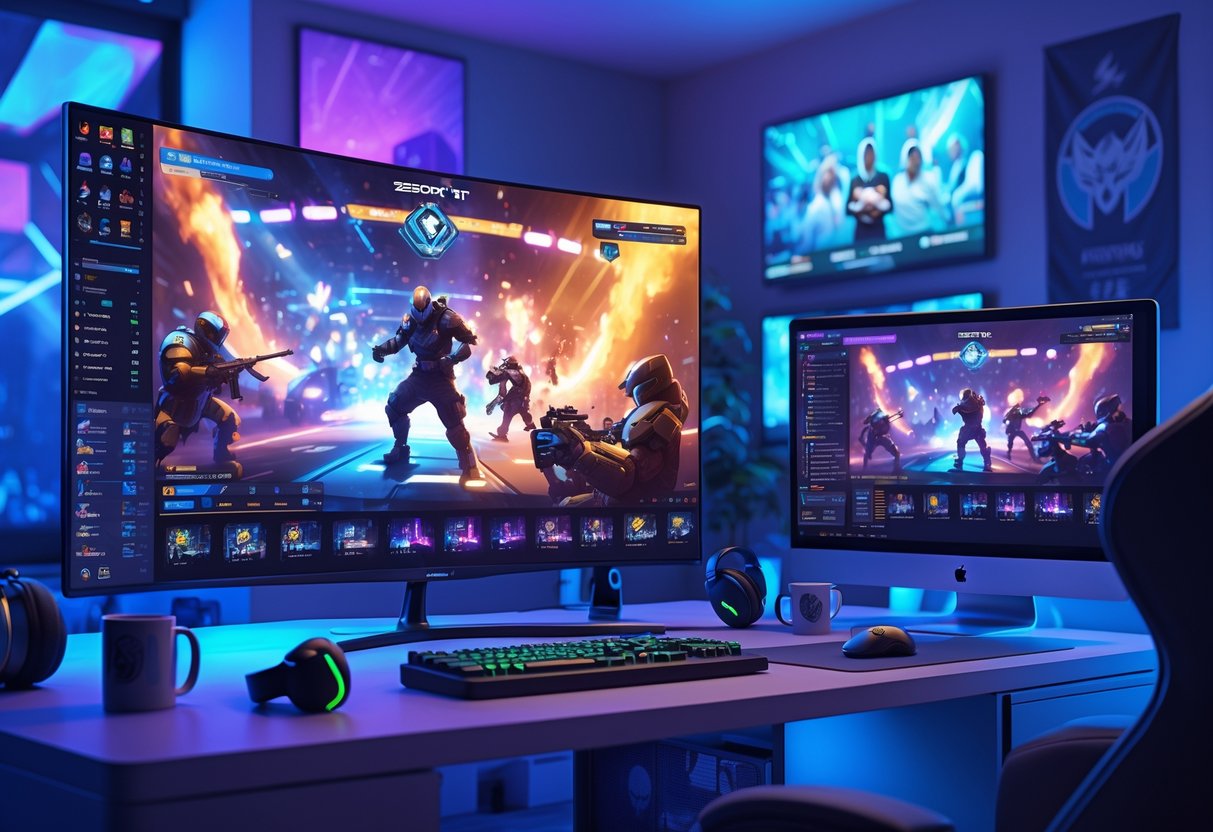
You can catch esports tournaments on big streaming platforms like Twitch and YouTube Gaming, or sometimes on TV channels like ESPN and BBC. Most tournaments stream live for free online, while TV usually only covers the biggest championship events with top-notch production quality.
Mainstream Television Options
ESPN leads the way for esports on traditional TV in a lot of places. They show major tournaments like the League of Legends World Championship finals and some CS events. BBC picks up high-profile tournaments too, especially during championship weekends.
Cable channels like TBS have aired specific leagues, like ELEAGUE. These broadcasts come with pro commentary and analysis, much like traditional sports coverage. You get higher production values—think multiple cameras and expert panels.
TV coverage is still pretty limited compared to online. Most of it focuses on finals or semifinals, not the whole event. Check your local listings around big championship periods since coverage changes by region and provider.
Major Streaming Services for Fans
Twitch is still the main place to watch esports tournaments. Most big competitions stream live here, like The International, Valorant Champions, and regional leagues. The platform’s interactive chat features and flexible viewing options are a huge draw.
YouTube Gaming has picked up exclusive rights for some tournaments. Call of Duty League and Overwatch League stream only on YouTube. The interface makes it easy to catch up on missed matches, with highlights and replays ready to go.
Facebook Gaming hosts select tournaments and regional events. It’s not as big as Twitch or YouTube, but it offers community features that tie into existing Facebook groups and pages.
Sites like ESL Play and official tournament channels let you watch events directly, often with special coverage and behind-the-scenes content.
Frequently Asked Questions
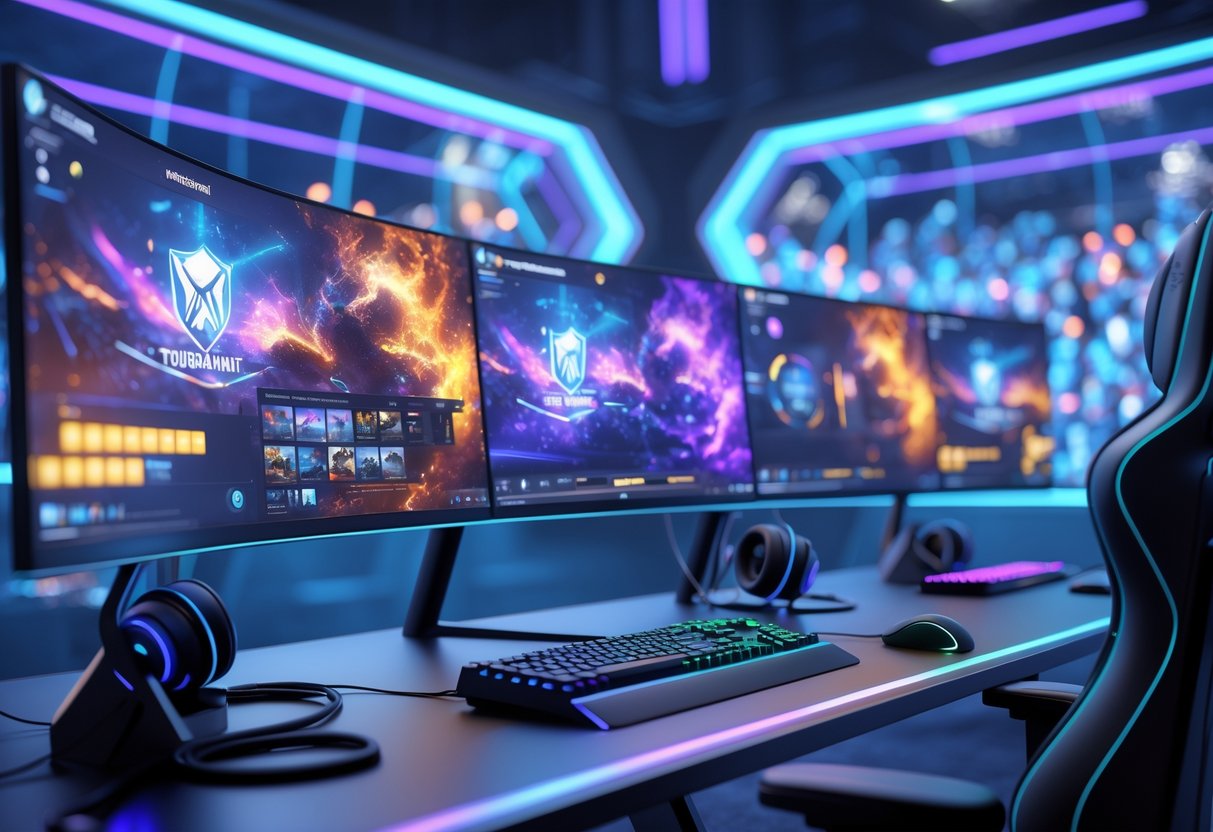
Setting up tournament streaming can feel overwhelming at first. Most questions focus on equipment, software setup, and how to broadcast without breaking the bank.
What equipment is needed to get started with live streaming sporting events?
You’ll want a decent camera, a solid microphone, and a stable internet connection to start. A basic DSLR or mirrorless camera usually does the trick.
For audio, grab a directional microphone to keep commentary clear and cut down on background noise. USB mics like the Audio-Technica ATR2100x-USB are good quality without costing a fortune.
Your computer should have enough processing power for streaming—at least 8GB RAM and a dedicated graphics card are recommended.
If you’re streaming console tournaments, you’ll need a capture card. The Elgato HD60 S is a favorite for its reliability.
Don’t overlook lighting. Two LED panels can boost your video quality for not much money.
Which streaming software do you recommend for broadcasting local sports?
OBS Studio is our go-to for beginners. It’s free and can handle multiple cameras and audio sources easily.
XSplit is easier to use but you’ll need a paid subscription for the advanced stuff. It’s worth a look if you want fast setup.
For big productions, vMix gives you pro mixing power. It’s pricier but delivers broadcast-quality results for major tournaments.
Streamlabs OBS combines streaming tools with built-in chat and alerts. It’s handy if you want audience interaction features right out of the box.
Can you guide me on setting up OBS for high-quality sports streaming?
Set your output resolution to 1080p at 30fps for smooth streaming. Higher frame rates use more bandwidth and processing power, so only go higher if your setup can handle it.
Use x264 for your encoder with a medium CPU preset. Set your bitrate between 3000-6000 kbps, depending on your upload speed.
Make separate scenes for each part of your tournament—player intros, gameplay, results screens. This keeps things looking sharp.
Add audio filters like noise suppression and gain control to clean up your commentary. OBS’s built-in filters work just fine for most setups.
Set up hotkeys for scene switching so you can move between cameras or graphics without awkward pauses.
How can I stream live sports directly from a switcher?
Connect your video switcher’s program output to a capture card with HDMI or SDI cables. Make sure the capture card matches your switcher’s output resolution.
Set up your streaming software to use the capture card as a video source. Most modern switchers output clean feeds that are perfect for streaming.
Run your stream audio through the switcher’s outputs instead of separate mics. This gives you better mixing control during live events.
Monitor your stream output separately from the switcher’s preview screens. A dedicated streaming PC works best for this.
If your switcher supports NDI, try network streaming. It can cut down on extra equipment and save you money.
What are some effective ways to broadcast youth sports events for free?
YouTube Live lets you stream for free, and there aren’t any time limits. Of course, you’ll need at least 50 subscribers and a verified channel to unlock this feature.
Facebook Live is great for reaching parents and the local crowd. Try making an event page ahead of time—it helps build a little buzz.
Twitch gives you free streaming too, but honestly, it’s more popular with esports than with traditional sports. If you’re streaming a gaming tournament, this is probably your best bet.
Your smartphone, paired with apps like Streamlabs Mobile, can handle simple, no-cost broadcasts. This option is ideal for smaller, local games.
You can also team up with local sports organizations. Sometimes they’ll sponsor basic gear if you cover their tournaments. Most clubs love the extra exposure.
Which mobile app is best for streaming sports live to my audience?
Streamlabs Mobile packs in a bunch of features—custom overlays, multiple camera angles, even chat interaction. You can stream straight to all the big platforms, which is honestly pretty handy.
YouTube’s mobile app keeps things simple and the stream quality usually holds up. If you want to get a tournament going quickly, this one’s probably your best bet.
Facebook’s mobile streaming connects right into event pages and community groups. Parents love that they can share streams with family without much hassle.
Instagram Live shines for those quick, behind-the-scenes moments or short match highlights. Pair it with your main streaming app if you want a bump in engagement.
Twitch Mobile feels made for gaming tournaments, thanks to the built-in chat and easy clip tools. If you’re hoping to build a regular crowd, the community features definitely help.

